Recent advances in N-heterocyclic carbene-catalyzed radical reactions
2021-05-14LeiDaiSongYe
Lei Dai,Song Ye,*
a Beijing National Laboratory for Molecular Sciences, CAS Key Laboratory of Molecular Recognition and Function, CAS Research/Education Center for Excellence in Molecular Sciences, Institute of Chemistry, Chinese Academy of Sciences, Beijing 100190, China
b University of Chinese Academy of Sciences, Beijing 100049, China
ABSTRACT The N-heterocyclic carbene (NHC)-catalyzed reactions involving two-electron reaction pathway have been well-established.However,the development of NHC-catalyzed radical reactions is still in its infancy in terms of reaction types and enantioselectivity.In the past decade, several elegant NHC-catalyzed radical reactions have been developed, including NHC-catalyzed oxidation of aldehydes to esters,reductive coupling reactions using Breslow intermediate as SET reductant and NHC-catalyzed reactions via radical homoenolates, dienoaltes and trienolates.This review summarizes the recent advances in NHC-catalyzed reactions involving radical intermediates.
Keywords:N-Heterocyclic carbene Radical Photocatalysis Organocatalysis SET
1.Introduction
Over the past few decades, N-heterocyclic carbenes (NHCs)have witnessed great success in the field of organocatalysis[1–10].Since the NHC-catalyzed umpolung of aldehyde via Breslow intermediate [11], NHC-bound intermediates have been extensively studied, which can be divided mainly into two types, the electron-rich and electron-deficient intermediates (Fig.1) [5].These various intermediates offer many possibilities for carbene catalysis via two-electron reaction pathway.
Compared to the well-established NHC-catalyzed two-electron reaction pathway,the NHC-catalyzed reactions via single-electron transfer (SET) are far less developed [12–17].Although the NHCcatalyzed SET reaction has been elucidated in biochemistry for the decarboxylation of pyruvate [18], NHC-catalyzed SET radical pathways remain challenging and much less developed in synthetic chemistry.In recent years, several reports have demonstrated that NHC-catalyzed radical reactions are feasible.This review aims to give a brief summary on this issue.
2.NHC-catalyzed oxidation of aldehydes to esters
In nature, thiamine diphosphate (ThDP), a NHC precursor,works as coenzyme to catalyze the oxidative decarboxylation of pyruvate via pyruvate ferredoxin oxidoreductase [19–22].This process has been extensively studied, which involves mainly two steps, the decarboxylation via two electron transfer and two SET oxidation steps (Scheme 1).In the late 1990s, the one-electronoxidation potential of the anion of Breslow intermediate was determined (Eoox=-0.77) [23–26].
Inspired by oxidative decarboxylation of pyruvate in biological system, Studer and co-workers reported the pioneering work of the oxidation of aldehydes to esters via two SET oxidation steps of Breslow intermediate using the (2,2,6,6-tetramethylpiperidin-1-yl)oxy radical (TEMPO) as the oxidant (Scheme 2) [27].
After this pioneering work, there are many reports using SET oxidative strategy to convert aldehydes or enals into various products, such as esters and cycloaddition products [28–35].
3.Breslow intermediate as SET reductant
In 2014,Chi and co-workers reported an elegant β,β-coupling of nitroalkenes via Breslow intermediate as SET reductant(Scheme 3)[36].The coupling reaction is initiated by one electron oxidation of the Breslow intermediate 17 by nitroalkene 13 to form radical 19 which was characterized by electron paramagnetic resonance(EPR)spectroscopy.The radical 19 is coupled with nitroalkene 13 to form anionic radical intermediate 20 which then undergoes subsequent oxidation and protonation to form β,β-homo-coupling of nitroalkenes 16.At the same time, the Breslow intermediate undergoes two SET oxidation steps to form aycl azolium 22 which is trapped by methanol to form ester 15.
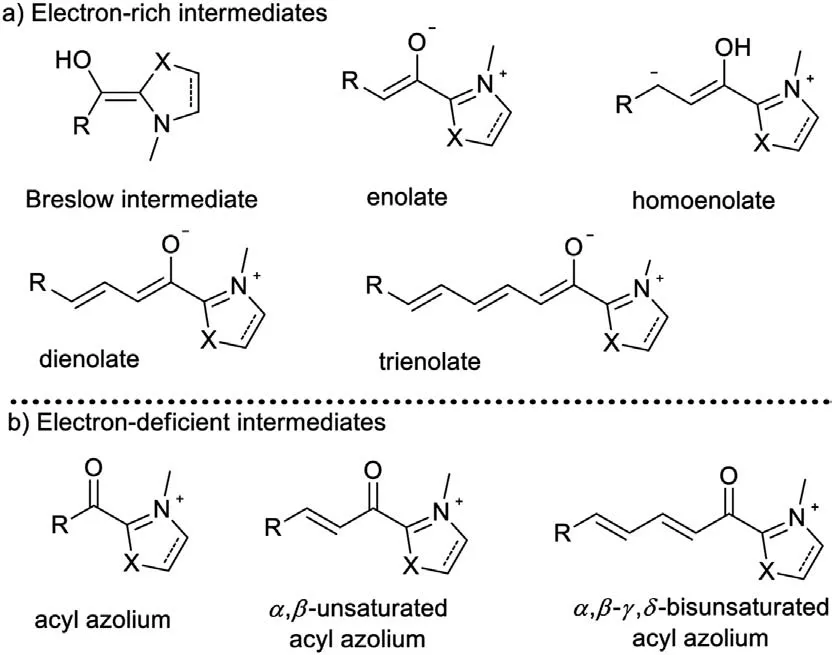
Fig.1.Intermediates in NHC catalysis via two-electron pathway.
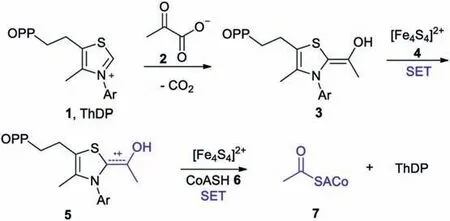
Scheme 1.Oxidative decarboxylation of pyruvate via thiamine diphosphate(ThDP).
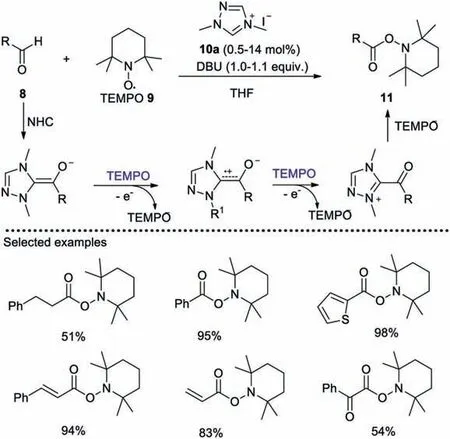
Scheme 2.Biomimetic carbene-catalyzed oxidations of aldehydes to esters.
Subsequently, using this strategy, the same group further developed some interesting reductive coupling and cascade reactions (Scheme 4).For example, the reductive coupling of nitrobenzyl bromides 23 with activated ketones or imines 24 was established (Scheme 4a) [37].They realized NHC-catalyzed reductive 1,4-addition of nitrobenzyl bromides 23 to nitroalkenes 28 with good yields (Scheme 4b) [38].An elegant NHC-catalyzed cascade reaction for the synthesis of multi-substituted indane derivatives 31 was also developed (Scheme 4c) [39].
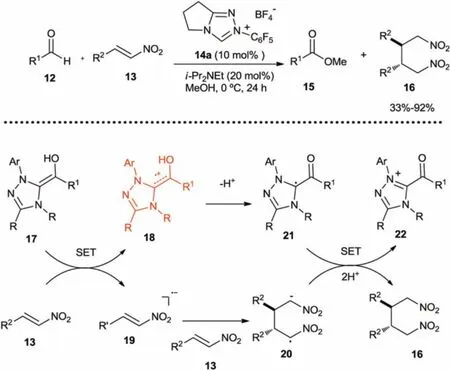
Scheme 3.β,β-Coupling of nitroalkenes.
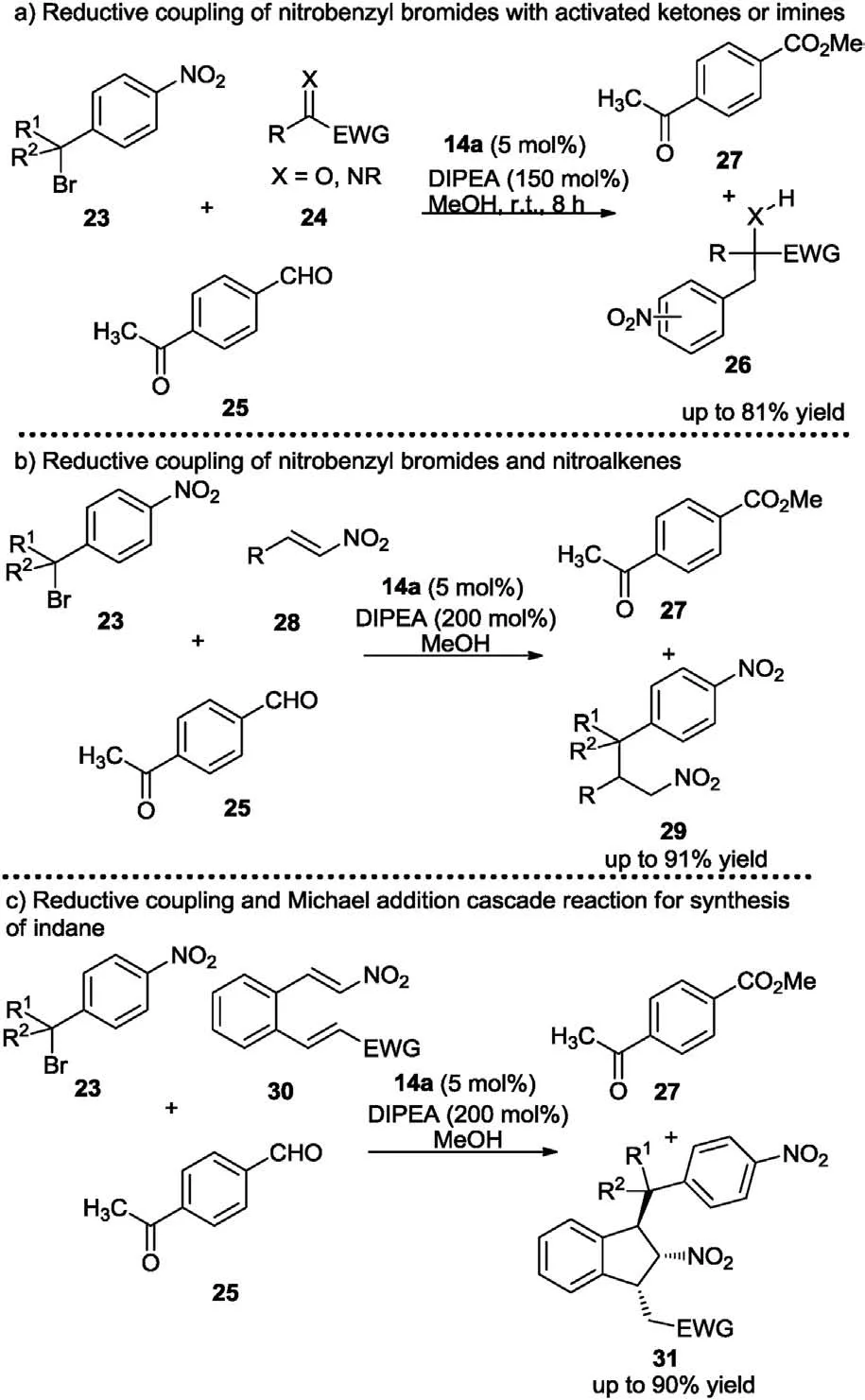
Scheme 4.The reductive coupling reactions with Breslow intermediate as SET reductant.
It is interesting that only electron deficient NHC-catalysts bearing N-C6F5group were effective for the reaction, which may owe to their suitable oxidation potential of the Breslow intermediates.

Scheme 5.NHC-catalyzed decarboxylative alkylation.
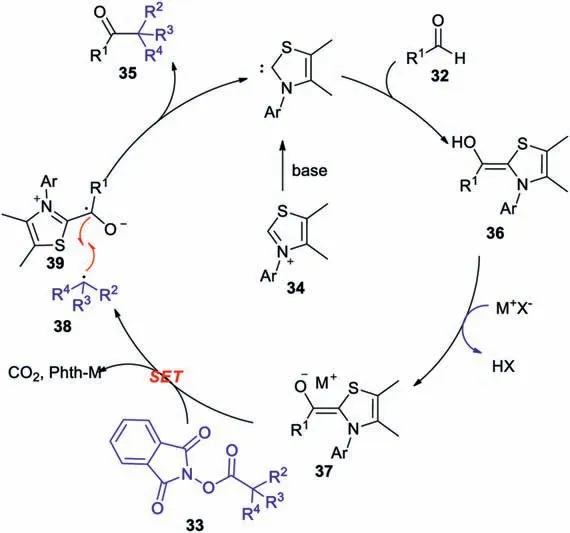
Fig.2.Possible mechanism for decarboxylative alkylation.
Very recently, Ohmiya and Nagao et al.reported the NHCcatalyzed decarboxylative alkylation of aryl aldehydes for construction of C(sp2)-C(sp3) bond via cross of coupling Breslow intermediate type radicals with tertiary or secondary alkyl radicals(Scheme 5) [40].This methodology allowed efficient synthesis of functionalized ketones including late stage modification of pharmaceutical drugs and natural products.The reaction of 32a with citronellic acid-derived 33a obtained radical cyclization product 35a in 14% yield.This radical ring-closing experiment strongly suggested that a carbon-centred radical was involved in this reaction.
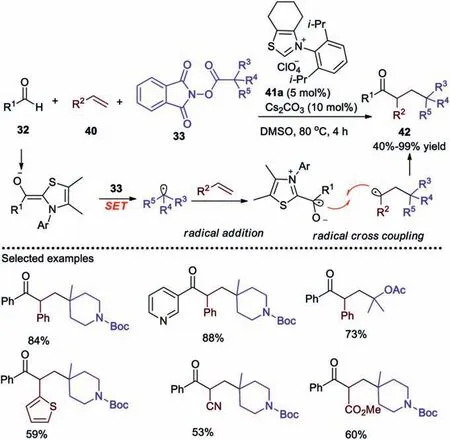
Scheme 6.NHC-catalyzed alkylacylation of alkenes via radical relay.
Based on a series of mechanistic experiments, they proposed the reaction mechanism as depicted in Fig.2.The reaction is initiated by formation of the Breslow intermediate 36, and then deprotonation of 36 by a base generates the intermediate 37.Subsequently,the SET between 37 and 33 gives alkyl radical 38 and Breslow intermediate type radical 39,respectively.Eventually,the radical–radical recombination gives the desired ketones 35 and regenerates the carbene catalyst.
Subsequently,the same group reported an interesting carbenecatalyzed vicinal alkylacylation of alkenes via radical relay strategy(Scheme 6) [41].They demonstrated that NHC-catalyzed radical relay strategy was a powerful method for vicinal alkylacylation of styrenes, acrylates and acrylonitriles.
Recently, this strategy was successfully applied for the NHCcatalyzed acylfluoroalkylatoin of alkenes by Li[42],Wang[43]and Wu et al.[44] independently (Scheme 7).
The Katritzky pyridinium salts was used successfully as the alkyl sources for the NHC-catalyzed alkylation of aldehyde and alkylacylation of alkene by Hong et al.(Scheme 8) [45].
The synergistic merger of NHC catalysis and photoredox catalysis for benzylation of acyl azolium was reported by Scheidt et al.(Scheme 9) [46].Oxidation of the Hantzsch ester 48 by excited-photocatalyst (IrIII*) gives benzyl radical, and SET reduction of the acyl triazolium provides the Breslow-derived ketyl radical by IrIIphotocatalyst.Eventually, the radical–radical cross coupling affords the desired ketones 49 and regenerates the carbene catalyst.

Scheme 7.NHC-catalyzed acylfuoroalkylation of alkenes via radical relay.

Scheme 8.NHC-catalyzed deaminative cross-coupling of aldehydes with Katritzky pyridinium salts.
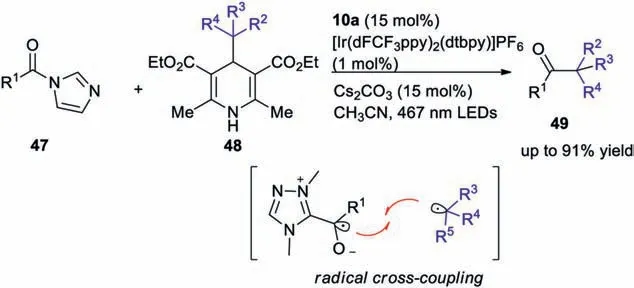
Scheme 9.Photo/NHC-cocatalyzed synthesis of ketones.

Scheme 10.NHC-catalyzed synthesis of d-ketocarbonyls via radical relay.
Very Recently,Ohmiya and Nagao et al.reported NHC-catalyzed synthesis of d-ketocarbonyls from enals, alkenes and tertiary αbromocarbonyls (Scheme 10) [47].
Notably,N-2,6-diisopropylphenyl thiazolium salts were used as the catalysts for most of these reactions, which implies the sterically hindered and electron-rich property are crucial for the efficient NHC catalysts.
4.Reactions via radical from homoenolate
In recent years, several reports have demonstrated that NHCcatalyzed reactions involving homoenolate radical as key bond formation are feasible, including the formation of C(sp3)-O and C(sp3)-C(sp3) bonds.
4.1.β-Hydroxylation of enals
Recently, Rovis group [48] (Scheme 11a) and Chi group [49](Scheme 11b)more or less simultaneously independently reported enantioselective β-hydroxylation of enals via nitrobenzene as SET oxidant.These two interesting reports are considered as significant breakthrough,because the homoenolate type radical was achieved for the first time via the oxidation of NHC-bound homoenolate intermediate.The SET oxidant is crucial for this process, nitropyridine N-oxide 53 and nitrobenzenesulfonic carbamate 56 were used, respectively.

Scheme 11.Enantioselective β-hydroxylation of enals.
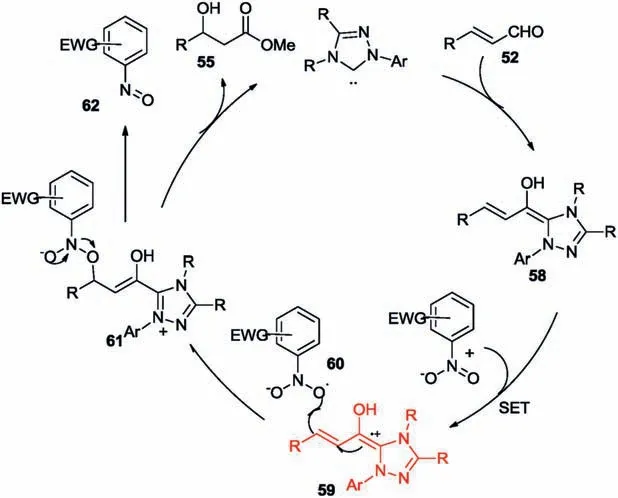
Fig.3.Possible mechanism for β-hydroxylation of enals.
The possible mechanism for β-hydroxylation of enals is depicted in Fig.3.This reaction starts from formation of the homoenolate intermediate 58,which undergoes oxidation with nitrobenzene to furnish homoenolate type radical 59 and nitrobenzene-derived radical anion 60.Subsequently,the cross coupling of radicals 59 and 60 is the key step for bond formation to form 61 which collapses to expel an NHC-bound alkoxide which is trapped by methanol to give β-hydroxylation ester 55 and nitrosobenzene 62.
Very recently, Chi and co-workers reported an alternative method for enantioselective β-hydroxylation of enals which combined chiral nitrobenzene and achiral carbene (Scheme 12)[50].

Scheme 12.Chiral nitrobenzene mediated enantioselective β-hydroxylation of enals.

Scheme 13.NHC-catalyzed enantioselective homo-and cross-coupling of the two homoenolates.
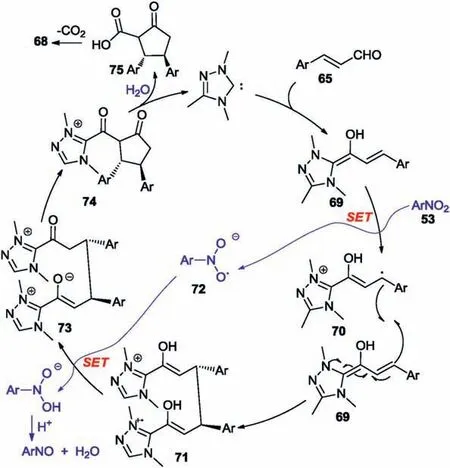
Fig.4.Possible mechanism for enantioselective homo- and cross-coupling of the two homoenolates.
4.2.Homo- and heterocoupling of enals
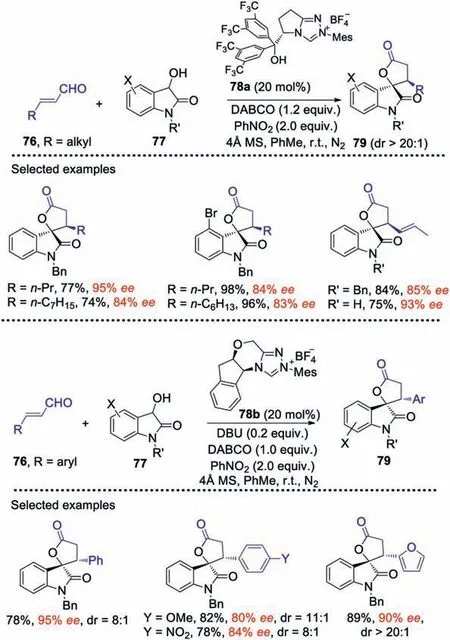
Scheme 14.NHC-catalyzed enantioselective cross coupling of homoenolate and enolate.
Rovis and co-workers reported the pioneering work of enantioselective homo- and cross-coupling of two homoenolates for construction of C(sp3)-C(sp3)bond in 2015(Scheme 13)[51].In their previous work, they developed enantioselective α-hydroxylation of enals using nitrobenzene as SET oxidant [48].During the investigations, they observed cyclopentanone products when the reaction was run in a non-nucleophilic solvent.After a series of condition screening,they found PhCF3to be the best solvent,giving 3,4-disubstituted cyclopentanones with good yields and enantioselectivity.
The possible mechanism for this reaction is depicted in Fig.4.The reaction starts from formation of the homoenolate intermediate 69, which undergoes SET oxidation with nitrobenzene to give homoenolate radical 70.Subsequently, the cross coupling of homoenolate radical 70 and homoenolate 69 is the key step for bond formation to form 71 which undergoes a second SET oxidation to form acyl azolium 73.The acyl azolium 73 is attacked by the enolate to form cyclopentanone 74.Then the cyclopentanone 74 is trapped by water to give β-ketoacid 75.The final product 68 is obtained from decarboxylation of β-ketoacid 75.
4.3.Radical coupling of homoenolate and enolate
Recently, our group reported the first example of NHCcatalyzed enantioselective cross coupling of homoenolate and enolate (Scheme 14) [52,53].The NHC-catalyzed oxidative [3+2]annulation of dioxindole and enals gave the spirocyclic oxindoleg-lactones in good yields with high to excellent diastereo- and enantioselectivities.It is worth noting that the challenging aliphatic enals also worked effectively in this reaction.A series of mechanistic investigations were conducted to clarify the possible mechanisms (Scheme 15).Pathway A is the oxidation of dioxindole to isatin followed by annulation with enals and pathway B is the two-electron oxidation of Breslow intermediate to acyl azolium followed by annulation with dioxindole.These two pathways were all ruled out by the control experiment.Next, we also conducted some TEMPO-trapping and EPR experiments to further clarify this reaction mechanism.We suggested that the cross coupling of homoenolate radical and enolate radical was the key step for this reaction.
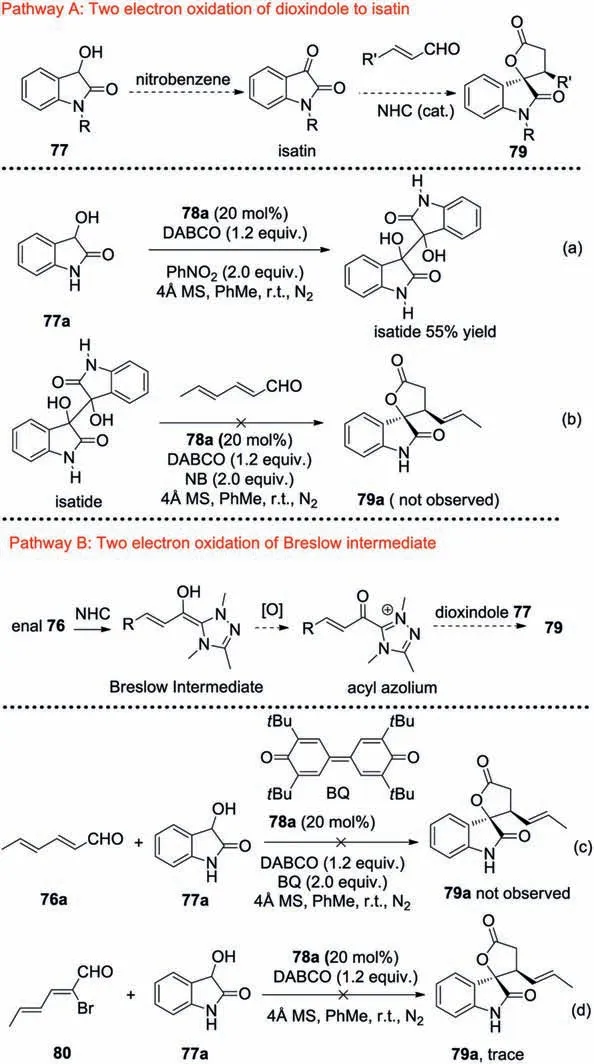
Scheme 15.Control experiments of enantioselective cross coupling of homoenolate and enolate.
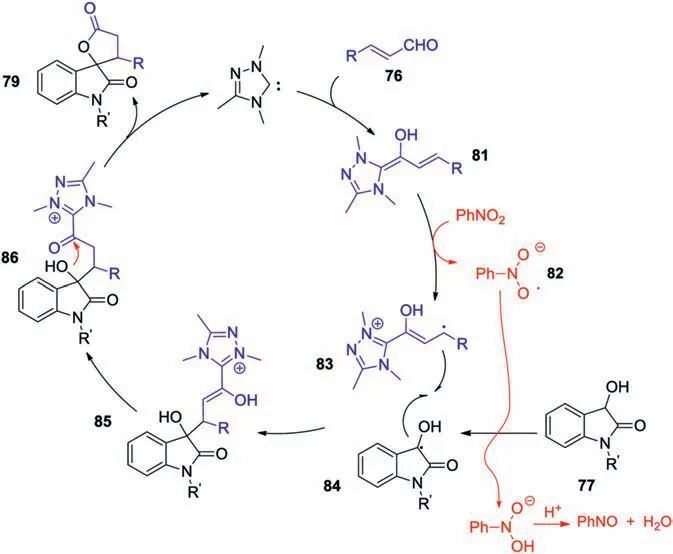
Fig.5.Plausible catalytic cycle.

Scheme 16.NHC-catalyzed dihalomethylenation of enals.
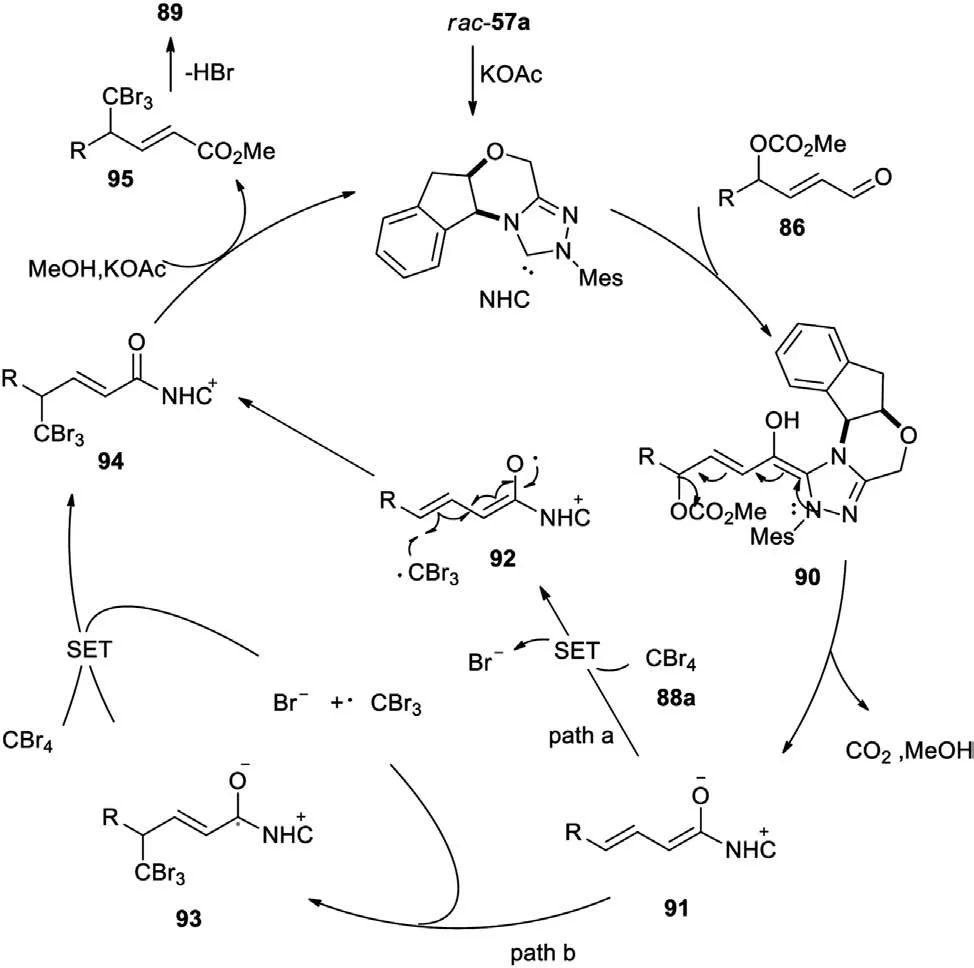
Fig.6.Possible mechanism for ihalomethylenation of enals.
The plausible catalytic cycle for this reaction is depicted in Fig.5.The reaction starts from formation of the homoenolate intermediate 81, which undergoes nitrobenzene oxidation to give homoenolate radical 83 and nitrobenzene-derived radical anion 82.Subsequently, the radical 82 could undergo hydrogen atom transfer from dioxindole 77 to obtain its enolate radical 84.The cross-coupling of the homoenolate radical 83 and the enolate radical 84 gives adduct 85, which is protonated to furnish acyl azolium 86.The lactonization of acyl azolium 86 gives the spirocyclic oxindolelactones 79 and regenerates the carbene catalyst.
5.Reactions via radicals from dienolate and trienolate
5.1.g-Dihalomethylenation of enals
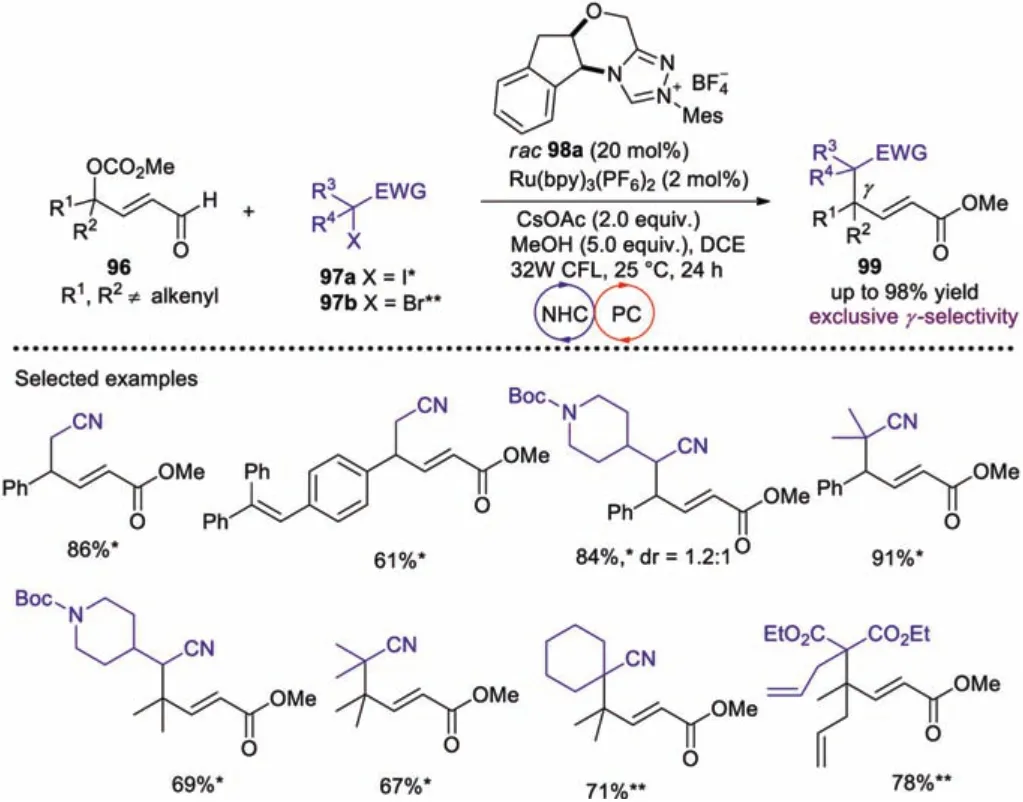
Scheme 17.-Alkylation of enals with simple alkyl radicals via photo/NHC cocatalysis.
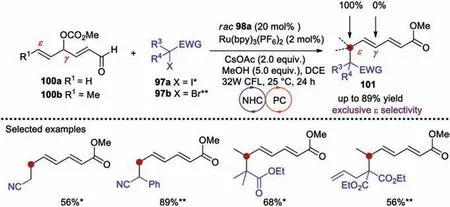
Scheme 18.Alkylation with radicals.
Sun and co-workers developed an elegant NHC-catalyzeddihalomethylenation of enals via radicals from dienolaes with CCl3Br and CBr4as SET oxidant (Scheme 16) [54].Notably, one example of NHC/photo cocatalyzeddichlomethylenation of enals gave the product in 42% yield using CCl4as terminal SET oxidant.However, further efforts to improve the yield proved fruitless.Luckily, they found CCl3Br and CBr4, which have more oxidation capacity, were efficient SET oxidants for this transformation without photocatalyst and light.
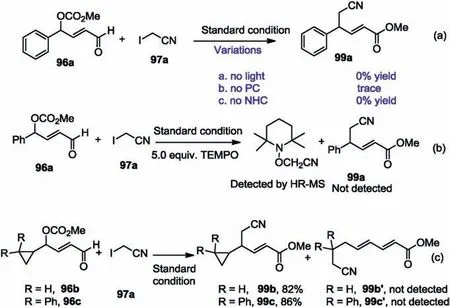
Scheme 19.Mechanism studies of photo/NHC-cocatalyzed remote alkylation.
NHC-catalyzed radical reactions with specific oxygen or functionalized carbon-centered radicals prompted us to develop more general NHC-catalyzedalkylation with alkyl radicals.The visible-light-mediate photoredox catalysis is a very powerful strategy to generate radicals [55].Very recently, our group successfully realized the merging of photoredox catalysis with NHC catalysis for efficient construction of C(sp3)-C(sp3)bond with alkyl radicals( Schemes 17 and 18)[56].The reaction of enals with alkyl halides gave themultisubstituted-α,β-unsaturated esters with exclusiveselectivity, including those with challenging vicinal all-carbon quaternary centers(Scheme ).NHC-catalyzed remote functionalization is still a challenge.In this work we reported the first example of NHC-catalyzed e-functionalization[57,58]via our rational design which was a series of enals bearing vinyl substituent at theposition that can generate trienolate intermediate via NHC catalysis (Scheme ).
Several mechanism studies were carried out (Scheme 19).The reaction without light, PC, or carbene gave no or trace desired product (Scheme 19a).The reaction was totally inhibited when TEMPO was added and radical coupling product between cyanomethyl radical and TEMPO was detected by HR-MS(Scheme 19b).The reaction of enal 96b and 96c, bearing a cyclopropyl group at theposition,with iodoacetonitrile gave the desired products 99b and 99c in excellent yield without the ringopening product 99b0and 99c0(Scheme 19c), which suggests the reaction pathway of alkyl radical addition to dienolate intermediate.
The proposed mechanism is depicted in Fig.7.The alkyl radical 102 generated from alkyl halide 97 via photoredox catalysis, was added to the dienolate intermediate 103,generated from enals 96 via carbene catalysis, to give homoenolate radical 104.The following SET oxidation of homoenolate radical 104 by the radical cation 105 of photocatalyst gives α,β-unsaturated acyl azolium intermediate 106.The acyl azolium intermediate 106 is attacked by methanol to afford the final products 99 and regenerates the NHC catalyst.
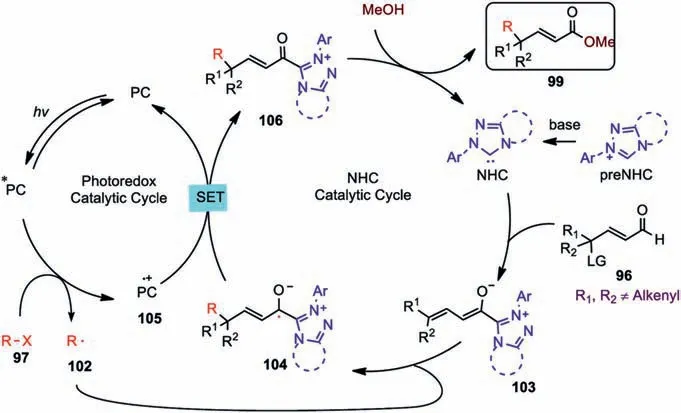
Fig.7.Proposed mechanism.

Scheme 20.Ring-opening and alkylation of cyclopropane enal.
5.3.Ring-opening and g-alkylation of cyclopropane enal
Very recently, our group successfully realized photo/NHCcocatalyzed ring-opening Cbond cleavage of cyclopropane enal and subsequent g-alkylation with alkyl electrophiles, giving the corresponding g-alkylated α,β-unsaturated esters in good yields(Scheme 20) [59].
6.Conclusions
Several elegant transformations via NHC-catalyzed radical reactions have been reported in the past decade.However, the development of this area is still in its infancy in terms of reaction types and enantioselective radical reactions.Considering the invaluable potential of this area, many more NHC-catalyzed radical reactions may be expected in the future.Especially,NHC-catalyzed enantioselective radical reactions and the merging of photoredox catalysis with NHC catalysis will be very valuable and arouse our attention.
Declaration of competing interest
The authors report no declarations of interest.
Acknowledgments
We are grateful for the financial support from the National Natural Science Foundation of China (Nos.21672216, 21831008),and the Beijing National Laboratory for Molecular Sciences ( No.BNLMS-CXXM-202003).
杂志排行
Chinese Chemical Letters的其它文章
- Quantitative assessment of rhodamine spectra
- Copper-cobalt-nickel oxide nanowire arrays on copper foams as self-standing anode materials for lithium ion batteries
- Design of activatable red-emissive assay for cysteine detection in aqueous medium with aggregation induced emission characteristics
- An aqueous zinc-ion hybrid super-capacitor for achieving ultrahigh-volumetric energy density
- Assembly and packing models of [Ti6Co12] ring based on the titanium-capped cobalt clathrochelates
- A stable Co(II)-based metal-organic framework with dual-functional pyrazolate-carboxylate ligand: Construction and CO2selective adsorption and fixation
